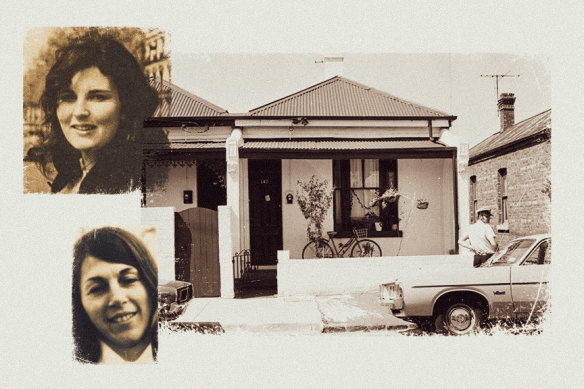The retired detective who still 'lives and breathes' the Easey Street ...
The retired detective who still ‘lives and breathes’ the Easey Street murder case
Peter Hiscock was a 30-year-old senior detective in the homicide squad when he got the call to attend a murder in Easey Street, Collingwood.

It was January 13, 1977, and the temperature was over 40 degrees.
The 1977 murders of Susan Bartlett (top) and Suzanne Armstrong in Easey Street, Collingwood shocked Melbourne.Credit: Stephen Kiprillis
Hiscock and his colleague Graeme McDonald walked in through the unlocked front door.
“What I saw I would never forget. I have lived and breathed that job every day since,” Hiscock told The Sunday Age.
Susan Bartlett’s body was near the front door. The 28-year-old had been stabbed more than 50 times. In a bedroom was Suzanne Armstrong, 27. She had been stabbed almost 30 times – in three wounds to the heart – and raped.
The murder scene was not discovered for three days.
The hallway where the body of Susan Bartlett was found near the front door.
“At the post-mortem I had to count every single wound and record them. It was graphic and traumatic for a 30-year-old, but I knew it had to be done,” Hiscock said.
“It was important.”
The killer had tried to clean the crime scene, but it was impossible. There was just too much blood.
Loading
Later, forensic examination showed the killer had taken a shower while the victims lay on the floor. Armstrong’s 16-month-old baby was in his cot.

Hiscock on Saturday said the arrest of a suspect – a 65-year-old dual citizen of Australia and Greece – at an airport in Rome in the early hours on Friday was a great relief.
“I thought I would go to my grave with the case unsolved,” he said.
“[Today’s homicide detectives] have done an outstanding job. Who could believe it would be a 17-year-old [suspect]?
“The girls used to leave the front and back doors unlocked. They were very trusting.”
Hiscock remembers walking the streets, knocking on doors, in heat that he thought would melt the soles of his shoes.
He believed the likely killer was crime reporter John Grant, who was staying next door and had been one of the last people to see another woman who disappeared.
“He would have known there were two girls next door,” Hiscock said.
But a DNA test decades later cleared Grant.
Loading
“Back then there was no CCTV, phone pings or DNA. It was a different type of investigation.”
The man who has been arrested in Rome was checked near Easey Street around the time of the murders, when he was a teenager. He was carrying a knife, but was released.
Hiscock said a Greek teenager carrying a knife at the time would not be suspicious.
“The Kane brothers [standover men at the time] were driving around in a car, knocking over Greek traders riding on their bicycles to rob them, and so they were carrying knives for protection.”
Hiscock said the fresh investigators would have had to find police documents from the time that recorded stopping the teenager near the scene.
“We were always taught the answer would be in the file,” he said.
John Silvester lifts the lid on Australia’s criminal underworld. Subscribers can sign up to receive his Naked City newsletter every Thursday.
Loading



























































